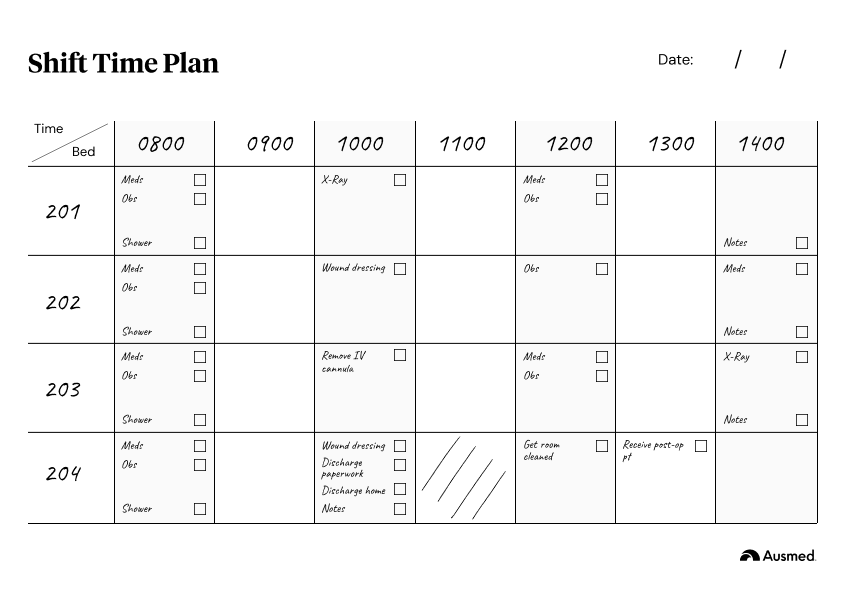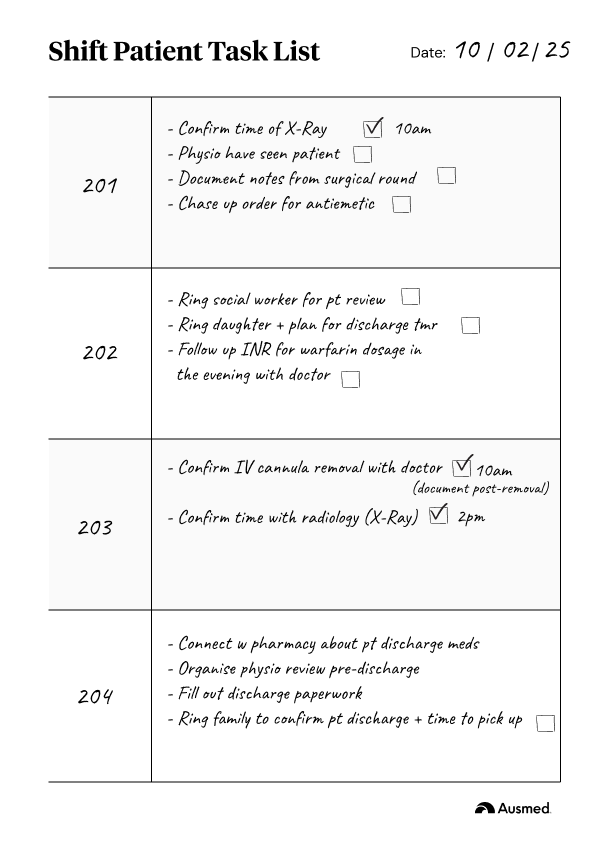Grad Guide to Time Management

Get notified when new graduate content drops.

Who wrote this Guide?
Renee Di Giuseppe is a passionate critical care nurse with over 18 years of nursing experience. Starting her career as a Division 2 nurse (enrolled nurse), she worked her way up through various clinical and leadership roles. Renee’s true passion lies in leadership, and he held an Associate Nurse Unit Manager role. Renee would ensure that graduate nurses would receive the support and care they deserve to navigate the challenges of transitioning into the workforce. As an experienced nurse, Renee combines her clinical expertise, leadership with her love of teaching to create supportive and engaging learning environments. She believes in fostering confidence, critical thinking, and teamwork among new nurses to help them thrive in their roles. Whether it’s through bedside teaching, running workshops, or presenting on clinical topics, Renee is dedicated to empowering the next generation of healthcare professionals.
I remember my first shift as a graduate nurse as if it were yesterday. Just reflecting on the stress I felt sitting in the handover room gives me goosebumps. I recall arriving early, looking around the room at all the posters on the wall, watching the second hand on the clock tick away while mustering the confidence to say hello to the nurses entering the room.
While experiencing all these feelings, I also had to listen to a 30-minute group handover and try to make sense of all the medical jargon.
Healthcare is a fast-paced environment, and it can be a scary place to begin with, especially for a new graduate nurse. Being as organised as possible is key to providing safe, high-quality patient care while maintaining your own well-being as a healthcare professional.
What Does ‘Good’ Time Management Look Like in Nursing?
Time management in nursing involves organising and prioritising tasks to ensure that all patient care activities are completed safely and efficiently during a shift. It also includes planning, adapting to unforeseen situations, and delegating tasks as needed.
Good time management allows you to meet patient needs and expectations while staying on top of documentation, medication administration, and patient care needs.
There are two key benefits to effective time management: Improved patient safety and reduced stress.
1. Patient Safety
Every second counts in nursing, and timely interventions can significantly impact patient outcomes. Actions such as administering medications, performing clinical assessments, or responding to patient deterioration must be carried out promptly to ensure safe and effective care. So, where do you start? I found writing down the predictable tasks first, so I know what my day should look like, but also ready to hand it off to someone if things go pear-shaped (meaning, not going to plan!)
Consider this scenario: A patient begins showing signs of respiratory distress, such as shortness of breath and decreased oxygen saturation. Recognising these symptoms and escalating care is your primary focus. However, you have other patients to care for! What do you do? It all starts with time management. A clear plan and prioritisation enable you to handle critical situations effectively while addressing other patients’ needs.
Nurse-to-patient ratios also play a significant role in patient safety. During a day or afternoon shift in a ward setting, you may care for 4–5 patients; on night shifts, this can increase to 8–10 patients. It’s completely normal to feel overwhelmed at first many, if not all, graduate nurses do, and it can take weeks to find your rhythm.
Be kind to yourself as you adjust. With time and practice, managing your workload will become more natural. You’ll develop the skills to prioritise tasks, and your confidence will grow with each shift. Remember, patient safety is always your top priority, and you are never alone, although it can feel like that sometimes.
2. Reduced Stress
I can vividly remember those moments when the stress would hit hardest, often not during my shift, but when I was at home, replaying the day in my mind. I’d feel like I hadn’t managed my time well enough, and sometimes, I’d even convince myself that I’d failed because things didn’t go as planned. That sinking feeling was real, and there were times I’d find myself calling the ward, worried I’d forgotten something important like signing off on a medication.
Some days won’t go perfectly. All you can do is your best. Give yourself the time and space to breathe because you're making a difference even on the toughest days.
I encourage you to begin each shift by reviewing the patient handover notes and identifying immediate priorities. Divide your workload into smaller, manageable parts. Focus on one patient or task at a time to avoid feeling overwhelmed to begin with, even if it takes longer to complete. Reassess priorities as the shift progresses, especially if new tasks or emergencies arise.
Breaking down tasks can look something like this:
Activity: Wound Dressing
- Task 1: Perform a wound assessment.
- Task 2: Before you start, let your buddy nurse know that you may need assistance or a second opinion during the assessment.
- Task 3: Gather all necessary equipment before starting.
- Task 4: Clean and dress the wound.
- Task 5: Document the assessment, procedure, and patient response in the progress notes.
Writing tasks like this can help you stay organised and reduce feeling overwhelmed, especially when starting out. Each sub-task is important, so take your time, focus on one step at a time, and always ask for help when needed. Remember, no one knows everything, it’s okay to learn as you go!
Steps for Effective Time Management
1. Plan ahead
Planning ahead often felt overwhelming, but I quickly realised it was key to starting my shift on the right foot. I made it a habit to arrive 10-15 minutes early, grab the handover sheet, make a tea, sit down, and review the list of patients. What was I looking for? I was looking for “red flags.” Who on the handover sheet screamed out, “Look at me?”
This routine helped me train my brain to anticipate potential issues and develop a plan before the formal group handover began. When patients were allocated to me, I was prepared to think about how I would prioritise their care during the shift.
After the formal handover, I would document high-priority tasks on my planner. Let’s face it: the routine on the ward hasn’t changed, so you can expect that the following tasks will be on your time planner. This typically includes:
- Bed area safety checks
- Performing clinical assessments or observations (e.g. obs/vital signs)
- Administering medications
- Making beds
- Assisting with hygiene tasks (e.g., showers or washes)
- Checking intravenous lines or other medical equipment
- Preparing patients for theatre
Remember that unexpected high-priority activities are what make a busy shift even busier.
2. Create a visual time plan
A written plan will help you stay on track and control your shift.
Graduate nurses are exposed to new challenges daily, which can feel uncomfortable. Remember, it is very typical to feel like this as a learner. However, facing challenges presents the opportunity to demonstrate critical thinking skills.
I’ve been around for a long time to know that nurses are visual people. We love a plan. Mapping out tasks on paper seems simple but very effective. It helps us anticipate challenges and identify areas where we might need assistance or resources from the team or other interprofessional team members.

3. Create patient-specific to-do lists
Who doesn’t love a checklist? I love the dopamine feeling I get when I cross off a task. Although the time management plan is a great start to your day, there will always be things that creep up during your shift, such as:
- Taking a patient to an X-ray
- Unexpected admission from the theatre
- Commencing an IV infusion
All the activities listed above have multiple tasks associated with them. This means your day has already begun to shift into busy mode, and that’s okay.
So, step 3 is to write down all items for each patient on a to-do list, ideally the flip side of your time planner.

4. Prioritise patient care
Unexpected activities can arise at any moment. For example, an unplanned trip to the X-ray, an unexpected admission from the theatre, or administering a new intravenous iron infusion prescribed during morning rounds can feel overwhelming, but prioritising effectively will help you manage them safely and practically.
How do you know what to prioritise?
Examples of Priority Skills
Critical
- Responding to a patient with shortness of breath and low oxygen saturation.
- Organising analgesia for a patient who has just returned to the ward from surgery, reporting 8/10 pain
- Ring the surgeon to notify them that their patient has had 500 ml blood loss in their drain tube in the last 4 hours. The patient's blood pressure has decreased, with an increased heart rate.
High Priority
- Perform a routine blood glucose level on a patient who has diabetes and is fasting for a surgical procedure
- Commencing iron infusion
- Commence a crystalloid intravenous infusion for a patient who is hypovolaemic as per doctors' orders.
Routine
- X-ray
- Bed-making
- Writing progress notes
- Postoperative wash
- Pressure area care
Steps to Prioritise
5 key steps can help you respond to and manage any task, situation or activity, especially the critical and high-priority, often unexpected items.
1. Pause and assess the situation
Take a moment to evaluate the urgency of the new task. Ask yourself, “Does this need to be done immediately, or can it wait?”
2. Adjust your plan
Add the unexpected task to your list or time planner, but don’t panic. Move less urgent tasks to later in the shift if needed or hand it over to the next nurse on shift.
Focusing on one task at a time and trying to do everything simultaneously increases the risk of mistakes.
3. Communicate
Let your buddy nurse or team leader know about the unexpected task. They can support or help delegate routine duties to keep everything running smoothly.
Use concise and clear communication, e.g., “I’ve just been called to prepare a patient for an urgent X-ray. Can you assist with vitals for Patient B?”
4. Critical thinking skills
Break the task into smaller steps and tackle them systematically. For instance, preparing a patient for an X-ray might involve ringing radiology to confirm the time of the scan.
Let the patient know they are going for a scan. Prepare any relevant paperwork required for the scan. Book a patient service assistant for transport.
5. Reprioritise
Nursing is dynamic, and priorities can shift as new issues and challenges arise. Revisit your plan and adjust it as needed. Remember that hygiene care or bed-making can often wait, but medication administration or urgent procedures cannot. So call out for help and let your teammates know you are busy with a patient.
However, another patient in your care requires observation as they have just come back from theatre after having right hip replacement surgery.
Summing it up
Time management and prioritisation are skills that are learned over time. Tools like visual plans, checklists, and communication with your team to stay organised and maintain control, even during busy or unpredictable shifts.

Download Renee's Time Management Templates and Samples
PDFs that you can print out and store in your locker at work. You're welcome.
Keep reading

Boundaries

How Do You Reflect Effectively?
